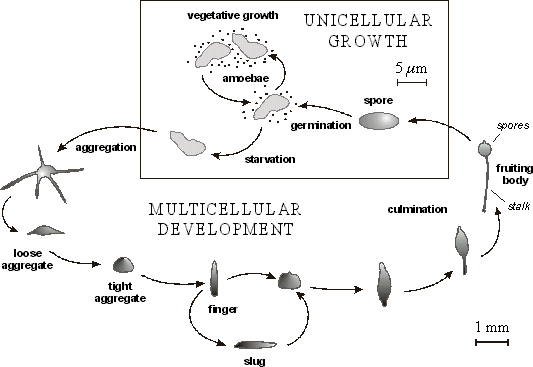Dictyostelid
|
|
| Dictyostelids | ||||||||
|---|---|---|---|---|---|---|---|---|
| Scientific classification | ||||||||
| ||||||||
| Families & Genera | ||||||||
|
Dictyosteliidae
|
The dictyostelids are a group of cellular slime moulds. When food is readily available they take the form of individual amoebae, which feed and divide normally. However, when the food supply is exhausted, they aggregate together to form a multicellular assembly, called a pseudoplasmodium or slug. This has a definite anterior and migrates to a new location, and under the correct circumstances matures to form a fruiting body, supporting one or more balls of spores. These spores are inactive cells protected by resistant cell walls, and become new amoebae once food is available.
In Acytostelium, the fruiting body is supported by a stalk composed of cellulose, but in other dictyostelids the stalk is composed of cells, sometimes taking up the majority of the original amoebae. With a few exceptions, these cells die once the stalk has been formed, and there is a definite correspondence between parts of the slug and parts of the fruiting body. Aggregation of amoebae generally takes place in converging streams. The amoebae move using filose pseudopods, and are attracted to chemicals produced by other amoebae. In Dictyostelium, aggregation is signalled by cAMP, but others use different chemicals.
Dictyostelium has been used as a model organism in molecular biology and genetics, and is studied as an example of cell communication, differentiation, and programmed cell death.
The entire genome of dictyostelium discoideum has now been published in Nature by geneticist Ludwig Eichinger and coworkers.
Mechanism of aggregation in Dicyostelium
Dicty_Signal_Relay.png
The mechanism behind the aggregation of the amoebae relys on Cyclic adenosine monophosphate (cAMP) as a signal molecule. One cell, the founder of the colony, begins to secrete cAMP in response to stress. Others detect this signal, and respond in two ways:
- The amoeba moves towards the signal.
- The amoeba secretes more cAMP to boost the signal.
The effect of this is to relay the signal throughout the nearby population of amoebae and cause inward movement to the area of highest cAMP concentration.
Within an individual cell, the mechanism is as follows:
- cAMP reception at the cell membrane activates a G-protein
- G protein stimulates Adenylate cyclase
- cAMP diffuses out of cell into medium
- Internal cAMP inactivates the external cAMP receptor.
- A different g-protein stimulates Phospholipase C
- IP3 induces calcium ion release
- Calcium ions act on the cytoskeleton to induce the extension of pseudopodia.
Because the internal cAMP concentration inactivates the receptor for external cAMP, an individual cell shows oscillatory behaviour. This behaviour beautiful spirals seen in converging colonies and is reminiscent of the Belousov-Zhabotinsky reaction and cyclic cellular automata
External link
- dictyBase (http://dictybase.org/) Online Informatics Resource for Dictyostelium

